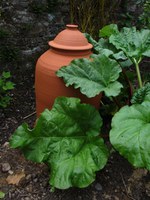Dakota Gardener: Forcing an early harvest
(Click an image below to view a high-resolution image that can be downloaded)
By Emily How, Horticulture agent
NDSU Extension – Ward County
There is a song going viral right now on social media about a woman named Barbara who is famous for her rhubarb pie. The entire song is a German tongue twister and catchy.
Rhubarb is also trending due to a trend of people “forcing” rhubarb, a growing technique that is used for an earlier and tastier rhubarb harvest. I guess rhubarb is a pretty popular plant worldwide.
Growing rhubarb is a widespread practice in most North Dakota gardens. This plant can grow quite large and take over an entire section of a garden. Rhubarb is also one of the first edible plants that we see emerge in spring. So, the concept of forcing rhubarb intrigued me, especially with claims of brighter color, longer stalks and earlier harvest.
Forcing rhubarb starts at the beginning of the rhubarb season when the leaves emerge. After removing any weeds and debris from the rhubarb plant, add compost for nutrients - around, but not touching the plant. A bucket or rhubarb “forcer,” a bell-shaped terracotta pot with a lid, is then placed over the plant. The rhubarb is then grown in complete darkness for seven to eight weeks, or until the stems are long enough to harvest.
According to Smithsonian Magazine, this process started in the United Kingdom and dates back to 1817, when someone accidentally dropped a bucket on a rhubarb plant and left it. When the bucket was removed the stalks were a deep red color. This started the large-scale practice of transplanting rhubarb into windowless, warm sheds and forcing the rhubarb.
So why does forcing rhubarb work? The darkness causes the stem to shoot up looking for the light to photosynthesize and make food. Because of the rhubarb’s rhizome root system, it can use all the food storage available to fuel this rapid growth, leading to long stems and an earlier harvest.
For the best results, use third-year plants or older because they will have more food storage built up. A word of caution, if you decide to try out this method of growing rhubarb, do not repeat it on the same plant multiple years in a row as it will not be able to recover properly.
A large rhubarb plant can easily be divided to share with your family and friends. In early spring or late fall, take a sharp spade or shovel and divide the crown leaving three to four buds on the parent plant. Do not harvest from the rhubarb plant the first year and harvest minimal amounts the second year. By the third year, your rhubarb plant should be at optimal production. Make sure you do not overharvest your rhubarb to have some for next year!
To harvest your rhubarb, simply pull firmly and twist. The rhubarb should snap off and be ready to make your favorite rhubarb dish or maybe try your hand at Barbara’s famous rhubarb pie!
NDSU Agriculture Communication – May 1, 2024
Source: Emily How, 701-857-6444, emily.how@ndsu.edu
Editor: Kelli Anderson, 701-231-7006, kelli.c.anderson@ndsu.edu




